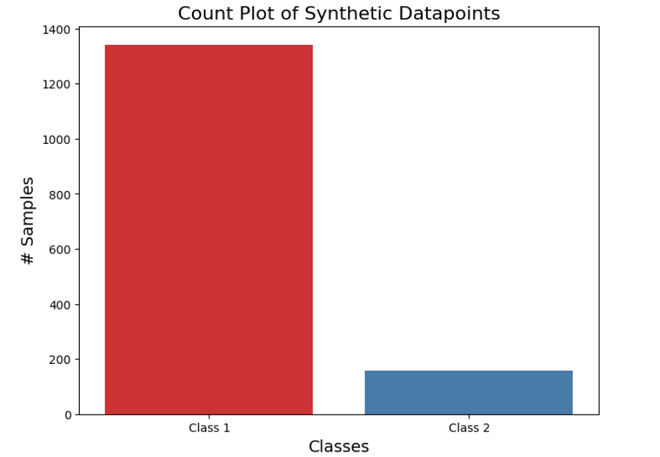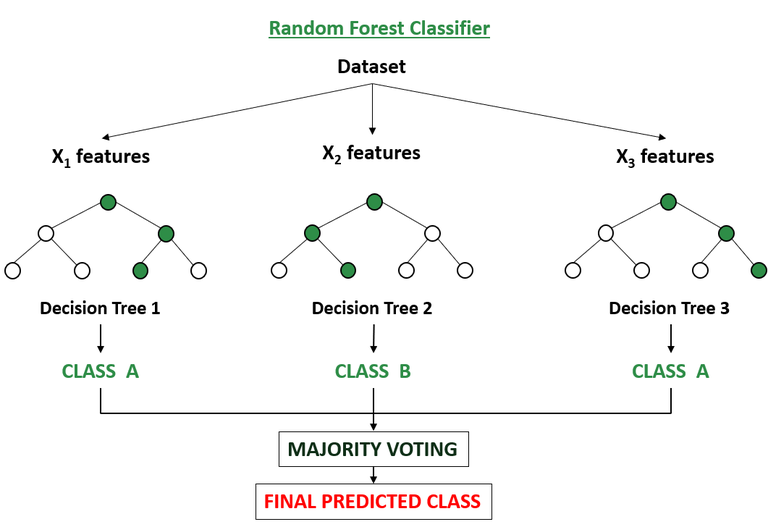
|
|
Ensemble learning techniques like bagging and random forests have gained prominence for their effectiveness in handling imbalanced classification problems. In this article, we will delve into these techniques and explore their applications in mitigating the impact of class imbalance. Classification problems are fundamental to machine learning and find applications across various domains. However, a prevalent issue in such tasks is handling imbalanced datasets, where one class significantly outweighs the other. This class imbalance presents a hurdle for conventional classifiers as they often exhibit a bias toward the majority class, resulting in skewed models. Bagging for Imbalanced ClassificationLet us start by exploring Bagging Techniques for Imbalanced Classification problem. Standard BaggingEnsemble learning is a machine learning approach that involves using multiple learning algorithms to create a stronger model than an individual model. Bagging, or bootstrap aggregating, is one of these techniques involving creation of multiple models on different subsets of the training data and then combining their predictions. It combines two key concepts: bootstrapping and aggregation.
ImplementationWe will explore the impact of bagging on imbalanced classification using a simplified example on an imbalanced dataset using the scikit-learn library. For this, we generate an imbalanced dataset with 2 target classes and a class distribution of 90% for the majority class and 10% for the minority class. Python
Let’s visualize this class distribution: Python
Output:
After visualization we will train our Bagging Model: Python
Output:Bagging Classifier - Test Accuracy: 0.92 Bagging With Random UndersamplingIn order to further improve the performance of Bagging Classifier on Imbalanced Dataset, we can perform random undersampling of the majority class. This technique involves randomly eliminating instances from the majority class to achieve a balanced distribution in each bootstrapped sample. By doing so, the model is less likely to exhibit bias towards the majority class, thus enhancing its accuracy in classifying minority instances. ImplementationPython
Output: Bagging Classifier with Random Undersampling - Test Accuracy: 0.96 Random Forest for Imbalanced ClassificationNow that we have an idea about Bagging techniques, let’s understand Random Forest and how it can be used for Imbalanced Classification problem. Standard Random ForestRandom forest is a variation of bagging that deploys decision trees as the base models. It trains each decision tree on a random subset of the training data and a random subset of the features and at the time of prediction, the random forest algorithm aggregates the predictions of all the individual decision trees to make a final prediction with higher predictive accuracy and also control over-fitting. For classification tasks, after each tree has been trained on a subset of the training data, in order to make a prediction for a new data point, the random forest algorithm passes the data point through each decision tree in the forest. After this, each tree independently predicts the class of the data point. If a certain class receives the highest number of votes across all trees, that class becomes the predicted class. |
# Import Required Librariesfrom sklearn.datasets import make_classificationfrom sklearn.model_selection import train_test_split# Generate an imbalanced datasetX, y = make_classification(n_samples=1500, n_features=15, n_informative=5, n_redundant=1, n_classes=2, weights=[0.90, 0.10])# Split the dataset into training and testing setsX_train, X_test, y_train, y_test = train_test_split(X, y, test_size=0.3, random_state=42) |
After data split we will train Random Forest model:
Python
# Standard Random Forestfrom sklearn.ensemble import RandomForestClassifierfrom sklearn.metrics import accuracy_score# Create a Random Forest classifier rf = RandomForestClassifier(n_estimators=100)# Train the Random Forest classifier on the training datarf.fit(X_train, y_train)# Make predictions on the test sety_pred_rf = rf.predict(X_test)# Calculate the accuracy of the modelacc_rf = accuracy_score(y_test, y_pred_rf)print(f"Standard Random Forest Accuracy: {acc_rf:.2f}") |
Output:
Standard Random Forest Accuracy: 0.96
Random Forest With Class Weighting
Another way that we can handle class imbalance is by adjusting the weights assigned to each class in the Random Forest algorithm aka Class Weighting. When we give more weight to the minority class and less weight to the majority class, the algorithm pays more attention to the minority class during training. This allows the model to learn from the imbalanced data more effectively, leading to better performance on predicting the minority class.
Implementation
Python
# Random Forest with Class Weightingfrom sklearn.ensemble import RandomForestClassifierfrom sklearn.metrics import accuracy_score# Create a Random Forest Classifier with Class Weightingrf_cw = RandomForestClassifier(random_state=42, class_weight="balanced")# Train the Random Forest classifier on the training datarf_cw.fit(X_train, y_train)# Make predictions on the test sety_pred_cw = rf_cw.predict(X_test)# Calculate the accuracy of the modelacc_cw = accuracy_score(y_test, y_pred_cw)print(f"Random Forest with Class Weighting Accuracy: {acc_cw:.2f}") |
Output:
Random Forest with Class Weighting Accuracy: 0.93
Random Forest With Bootstrap Class Weighting
Bootstrapping process is a vital aspect of Random Forests, and by combining Class Weighting with bootstrap we can quite effectively handle class imbalance in our data. In a traditional Random Forest model, each tree is trained on a bootstrap sample of the original data set, where samples may be repeated or left out. In Random Forest with bootstrap class weighting, additional weights based on class distribution are given to samples during bootstrapping, focusing more on minority class samples for improved classification accuracy on minority class instances.
Implementation
Python
# Random Forest with Bootstrap Class Weightingfrom sklearn.ensemble import RandomForestClassifierfrom sklearn.metrics import accuracy_score# Create a Random Forest classifier with Bootstrap Class Weightingrf_bcw = RandomForestClassifier(random_state=42, class_weight='balanced_subsample')# Train the Random Forest classifier on the training datarf_bcw.fit(X_train, y_train)# Make predictions on the test sety_pred_bcw = rf_bcw.predict(X_test)# Calculate the accuracy of the modelacc_bcw = accuracy_score(y_test, y_pred_bcw)print(f"Random Forest with Bootstrap Class Weighting Accuracy: {acc_bcw:.2f}") |
Output:
Random Forest with Bootstrap Class Weighting Accuracy: 0.94
Random Forest With Random Undersampling
Similar to bagging, random undersampling can be combined with random forests for improved performance on imbalanced datasets. By randomly removing some instances from the majority class in each bootstrap sample, we can balance the class distribution. This allows random forest classifiers to focus more on the minority class during training, potentially improving their ability to learn effectively from minority class instances and classify them correctly.
Implementation
Python
# Random Forest with Random Undersamplingfrom sklearn.ensemble import RandomForestClassifierfrom imblearn.under_sampling import RandomUnderSamplerfrom sklearn.metrics import accuracy_score# Apply random undersampling to the training setrus = RandomUnderSampler(random_state=42)X_train_resampled, y_train_resampled = rus.fit_resample(X_train, y_train)# Create a Random Forest classifier with random undersamplingrf_rus = RandomForestClassifier(random_state=42)# Train the Random Forest classifier on the resampled training datarf_rus.fit(X_train_resampled, y_train_resampled)# Make predictions on the test sety_pred_rus = rf_rus.predict(X_test)# Calculate the accuracy of the modelacc_rus = accuracy_score(y_test, y_pred_rus)print(f"Random Forest with Random Undersampling Accuracy: {acc_rus:.2f}") |
Output:
Random Forest with Random Undersampling Accuracy: 0.89
Conclusion
In conclusion, ensemble learning techniques such as bagging and random forests offer effective solutions to the challenges posed by imbalanced classification problems. By combining multiple base classifiers these techniques can improve model performance and generalization on imbalanced datasets. Through standard bagging, bagging with random undersampling, and various adaptations of random forests, practitioners can address class imbalance and build more robust classification models.
Reffered: https://www.geeksforgeeks.org
| AI ML DS |
Type: | Geek |
Category: | Coding |
Sub Category: | Tutorial |
Uploaded by: | Admin |
Views: | 15 |
